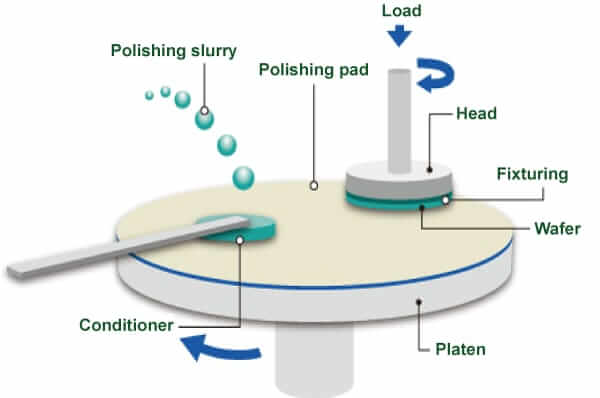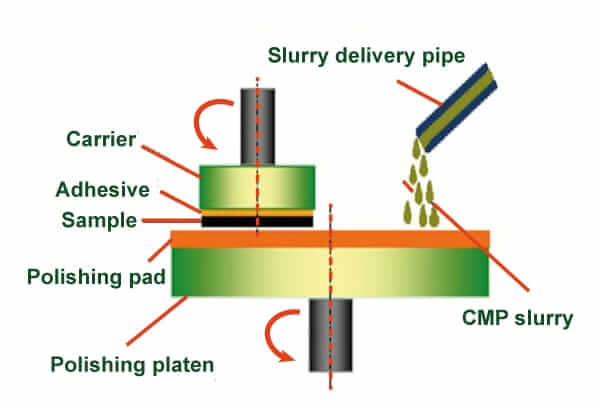Chemical Mechanical PolishingIntroduction:Chemical mechanical polishing is often termed as Chemical Mechanical Planarization or CMP. This is one of the latest and currently one of the most widely used processes for making the surface of objects smooth by combining both the chemical and mechanical forces. Thus, it is a type of partly mechanical and partly chemical process. It can be referred to as a hybrid of chemical etching (micro-fabrication) and free abrasive polishing of the surface. The role of CMP is multi-dimensional; it is used for a wide range of things such as, surface smoothening, material removal, planarization, uniformity control, defect reduction and more. Principle of CMP:The general mechanism of CMP is illustrated in following steps:
NOTE: There are certain terms related to CMP that one must know to understand the procedure completely, these are:
Working of CMP Method:
The process is illustrated in the image given below, which represents the CMP Machine: 

Both the chemical and mechanical processes are very crucial in this method, both of them are required because the physical grinding alone will cause huge damage to the component and might make it unfit for further use as any mechanically polished metal surface suffers a profusion of scratches, metal debris, and abrasives embedded in its surface, while, on the other hand the chemical process will not be sufficient enough to independently polish the surface completely. So a combination of both Chemical and Mechanical process is required. NOTE: There's a lot of friction involved in this method and thereby the friction generated by these processes can produce a huge amount of heat, so the temperature needs to be maintained very carefully.Uses and Application of CMP:
Advantages of CMP:
Disadvantages of CMP:
Conclusion:CMP has its own limitations, but despite this fact, it is a very successful method for surface polishing. Sometimes, interactions between the layers present inside the electrical equipment often lead to rough or uneven surfaces that need to be corrected and even small imperfections can bring about lots of issues such as problems in flow of current through the electric equipment, heat dissipation, component durability etc. All the defects such as grinding lines, scratches, pits and surface flaws including those damage that may affect a part's appearance, as well as its functionality are eliminated with the help of Chemical Mechanical Polishing. CMP is a latest technology that can bring the entire surface of the given material within the depth of field requirements of a photolithography system, or selectively remove material based on its position. |
 For Videos Join Our Youtube Channel: Join Now
For Videos Join Our Youtube Channel: Join Now
Feedback
- Send your Feedback to [email protected]
Help Others, Please Share









